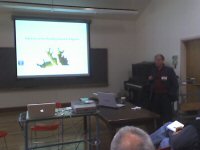Main Menu
Welcome
The interneutons responsible for generating the neural patterns (buccal motor programs, BMPs) interact to generate a continuum of programs to handle any feeding situations the animal might encounter. This is in contrast to the distinct classes of BMPs one usually uses to describe the behavior.
The properties of the buccal network are history-dependent, such that repeated stimulations trigger different responses depending on the previous stimulation history. We learned that the network has basically two different states and repeated stimulations (via cerebral-buccal interneuron 2) lead to transitions between these two states. Thus, depending on what state the network is in, the same stimulation will lead to different behavioral responses.
Transition between these states appears to be modulated by neuropeptides (e.g. small cardioactive peptide).

Posted on Thursday 07 June 2007 - 01:08:56 comment: 0
{TAGS}
{TAGS}
Render time: 0.0783 sec, 0.0058 of that for queries.





